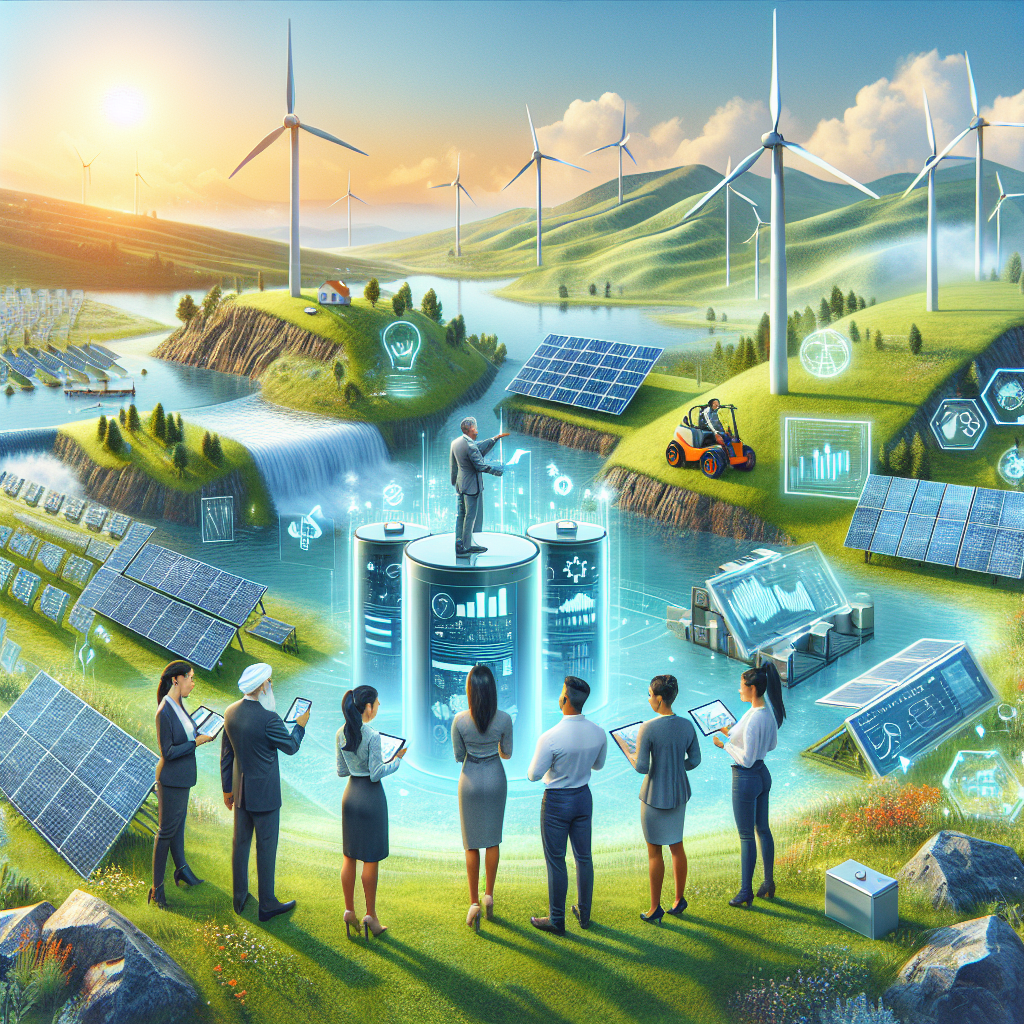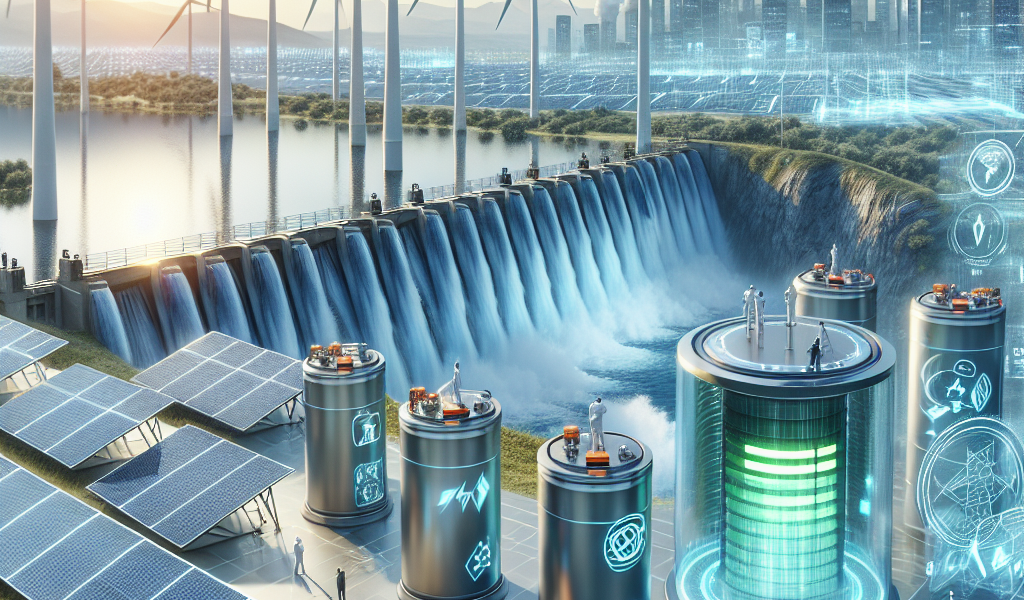-
Table of Contents
“Powering Tomorrow: Innovative Storage for a Sustainable Future”
Introduction

The future of renewable energy storage solutions is poised to revolutionize the global energy landscape, addressing one of the most critical challenges in the transition to sustainable power sources. As the world increasingly embraces renewable energy technologies such as solar, wind, and hydropower, the need for efficient, reliable, and scalable energy storage systems has become paramount. These storage solutions are essential for mitigating the intermittent nature of renewable energy, ensuring a stable and continuous power supply even when the sun isn’t shining or the wind isn’t blowing. Advances in battery technology, such as lithium-ion and emerging solid-state batteries, along with innovative approaches like pumped hydro storage, compressed air energy storage, and thermal energy storage, are at the forefront of this transformation. Additionally, the integration of smart grid technologies and artificial intelligence is enhancing the efficiency and responsiveness of energy storage systems. As research and development continue to drive down costs and improve performance, renewable energy storage solutions are set to play a pivotal role in achieving a sustainable, low-carbon future, fostering energy independence, and combating climate change.
Advances In Battery Technology For Renewable Energy Storage
The future of renewable energy storage solutions is a topic that has garnered significant attention in recent years, as the world increasingly shifts towards sustainable energy sources. One of the most promising areas of development in this field is advances in battery technology. As renewable energy sources like solar and wind power become more prevalent, the need for efficient and reliable storage solutions has never been more critical. Batteries, in particular, have emerged as a key component in addressing this challenge, and recent innovations are paving the way for a more sustainable future.
To begin with, lithium-ion batteries have long been the standard for energy storage, thanks to their high energy density and relatively low cost. However, as the demand for renewable energy storage grows, researchers and companies are exploring new materials and technologies to enhance battery performance. One such advancement is the development of solid-state batteries. Unlike traditional lithium-ion batteries, which use liquid electrolytes, solid-state batteries employ solid electrolytes. This change not only improves safety by reducing the risk of leaks and fires but also increases energy density, allowing for longer-lasting and more efficient storage.
In addition to solid-state batteries, another exciting development is the use of alternative materials such as sodium-ion and zinc-air batteries. Sodium-ion batteries, for instance, offer a more abundant and less expensive alternative to lithium. While they currently have a lower energy density compared to lithium-ion batteries, ongoing research aims to close this gap and make them a viable option for large-scale energy storage. Similarly, zinc-air batteries, which generate electricity through the reaction of zinc with oxygen from the air, promise a high energy density and low cost. These batteries are particularly attractive for grid storage applications, where cost-effectiveness and longevity are crucial.
Moreover, flow batteries represent another innovative approach to renewable energy storage. Unlike conventional batteries, flow batteries store energy in liquid electrolytes contained in external tanks. This design allows for easy scalability, making them ideal for large-scale energy storage projects. Vanadium redox flow batteries, for example, have shown great potential due to their long cycle life and ability to maintain capacity over time. As the technology matures, flow batteries could play a significant role in stabilizing the grid and ensuring a steady supply of renewable energy.
Transitioning from technological advancements to practical applications, it is worth noting that these innovations are already making an impact in various parts of the world. For instance, Tesla’s Powerwall and Powerpack systems have been deployed in numerous residential and commercial settings, providing reliable energy storage and helping to reduce reliance on fossil fuels. Similarly, large-scale battery installations, such as the Hornsdale Power Reserve in South Australia, have demonstrated the effectiveness of battery storage in stabilizing the grid and preventing blackouts.
Furthermore, government policies and incentives are playing a crucial role in accelerating the adoption of advanced battery technologies. Countries like Germany, China, and the United States are investing heavily in research and development, as well as offering subsidies and tax incentives to encourage the deployment of renewable energy storage solutions. These efforts are not only driving technological innovation but also making it more economically feasible for businesses and consumers to adopt sustainable energy practices.
In conclusion, the future of renewable energy storage solutions looks promising, thanks to significant advances in battery technology. From solid-state and alternative material batteries to flow batteries, these innovations are set to revolutionize the way we store and utilize renewable energy. As research continues and practical applications expand, we can expect to see a more sustainable and resilient energy landscape, ultimately contributing to a cleaner and greener planet.
The Role Of Artificial Intelligence In Optimizing Energy Storage Systems
As the world increasingly shifts towards renewable energy sources, the challenge of efficiently storing this energy becomes ever more critical. Solar panels and wind turbines generate power intermittently, creating a pressing need for advanced storage solutions that can ensure a steady supply of electricity. Enter artificial intelligence (AI), a transformative technology that is poised to revolutionize the way we manage and optimize energy storage systems.
Artificial intelligence, with its ability to process vast amounts of data and make real-time decisions, offers a promising avenue for enhancing the efficiency and reliability of energy storage. One of the primary ways AI can contribute is through predictive analytics. By analyzing historical data and weather patterns, AI algorithms can forecast energy production and consumption with remarkable accuracy. This predictive capability allows for better planning and management of energy storage, ensuring that surplus energy generated during peak production times is effectively stored and utilized during periods of low production.
Moreover, AI can optimize the operation of energy storage systems by dynamically adjusting the charging and discharging cycles. Traditional energy storage systems often operate on fixed schedules, which can lead to inefficiencies and increased wear and tear on the equipment. In contrast, AI-driven systems can continuously monitor the state of the grid, the condition of the storage units, and the demand for electricity. By making real-time adjustments, these systems can maximize the lifespan of the storage units and improve overall efficiency.
In addition to optimizing individual storage systems, AI can also play a crucial role in managing distributed energy resources. As more households and businesses install their own renewable energy systems, the grid becomes increasingly decentralized. This decentralization presents both opportunities and challenges. On one hand, it allows for greater resilience and flexibility; on the other hand, it complicates the task of balancing supply and demand. AI can help by coordinating the operation of these distributed resources, ensuring that energy is stored and released in a way that maintains grid stability.
Furthermore, AI can facilitate the integration of different types of energy storage technologies. Batteries, pumped hydro storage, and thermal storage each have their own advantages and limitations. By intelligently managing a diverse portfolio of storage solutions, AI can ensure that the most appropriate technology is used in any given situation. For example, during periods of high demand, AI might prioritize the use of fast-responding battery storage, while reserving longer-duration storage options for extended periods of low production.
The potential benefits of AI in optimizing energy storage systems extend beyond technical efficiency. By reducing the need for expensive infrastructure upgrades and minimizing energy waste, AI can also contribute to cost savings. These savings can be passed on to consumers, making renewable energy more affordable and accessible. Additionally, by enhancing the reliability of renewable energy sources, AI can help accelerate the transition away from fossil fuels, contributing to a more sustainable and environmentally friendly energy landscape.
In conclusion, the integration of artificial intelligence into energy storage systems represents a significant step forward in the quest for a sustainable energy future. Through predictive analytics, real-time optimization, and intelligent management of distributed resources, AI has the potential to transform the way we store and utilize renewable energy. As technology continues to advance, the role of AI in this field is likely to grow, offering new opportunities to enhance efficiency, reduce costs, and support the global transition to clean energy.
Emerging Trends In Grid-Scale Energy Storage Solutions
The future of renewable energy storage solutions is a topic that has garnered significant attention in recent years, as the world increasingly shifts towards sustainable energy sources. One of the most promising emerging trends in this field is grid-scale energy storage, which holds the potential to revolutionize how we store and distribute renewable energy. As renewable energy sources like solar and wind become more prevalent, the need for efficient and reliable storage solutions has never been more critical. This is where grid-scale energy storage comes into play, offering a way to balance supply and demand, and ensure a stable energy supply even when the sun isn’t shining or the wind isn’t blowing.
One of the most exciting developments in grid-scale energy storage is the advancement of battery technology. Lithium-ion batteries, which have been the standard for many years, are now being complemented by newer technologies such as solid-state batteries and flow batteries. Solid-state batteries, for instance, offer higher energy densities and improved safety compared to their lithium-ion counterparts. Flow batteries, on the other hand, provide the advantage of scalability and longer cycle life, making them particularly well-suited for large-scale energy storage applications. These advancements in battery technology are crucial for making renewable energy storage more efficient and cost-effective.
In addition to battery technology, other innovative storage solutions are also emerging. One such solution is pumped hydro storage, which has been around for decades but is now being reimagined with modern technology. This method involves using excess renewable energy to pump water uphill to a reservoir, which can then be released to generate electricity when needed. Another promising technology is compressed air energy storage, where excess energy is used to compress air and store it in underground caverns. When electricity demand is high, the compressed air is released to drive turbines and generate power. These methods, while not new, are being refined and optimized to better integrate with modern renewable energy systems.
Moreover, the integration of artificial intelligence (AI) and machine learning into energy storage systems is another trend that is gaining traction. AI can be used to predict energy demand and supply patterns, optimize the operation of storage systems, and even identify potential issues before they become problems. This level of intelligence and automation can significantly enhance the efficiency and reliability of grid-scale energy storage, making it a more viable option for widespread adoption.
Furthermore, the role of policy and regulation cannot be overlooked when discussing the future of renewable energy storage solutions. Governments around the world are recognizing the importance of energy storage in achieving their renewable energy targets and are implementing policies to support its development. Incentives such as tax credits, grants, and subsidies are being introduced to encourage investment in energy storage technologies. Additionally, regulatory frameworks are being updated to facilitate the integration of storage solutions into the existing grid infrastructure.
As we look to the future, it is clear that grid-scale energy storage will play a pivotal role in the transition to a more sustainable energy system. The advancements in battery technology, the resurgence of traditional storage methods with modern twists, the integration of AI, and supportive policy measures all point towards a bright future for renewable energy storage. While challenges remain, such as the need for further cost reductions and the development of standardized protocols, the progress being made is encouraging. With continued innovation and collaboration, grid-scale energy storage solutions will undoubtedly become a cornerstone of our renewable energy landscape, ensuring a reliable and sustainable energy future for generations to come.
Conclusion
The future of renewable energy storage solutions is promising, driven by advancements in battery technology, grid integration, and innovative storage methods such as pumped hydro, compressed air, and thermal storage. As renewable energy sources like solar and wind become more prevalent, efficient and scalable storage solutions are essential to ensure reliability and stability in energy supply. Continued research and development, coupled with supportive policies and investment, are expected to enhance the performance, reduce costs, and increase the adoption of renewable energy storage systems, ultimately contributing to a more sustainable and resilient energy infrastructure.





